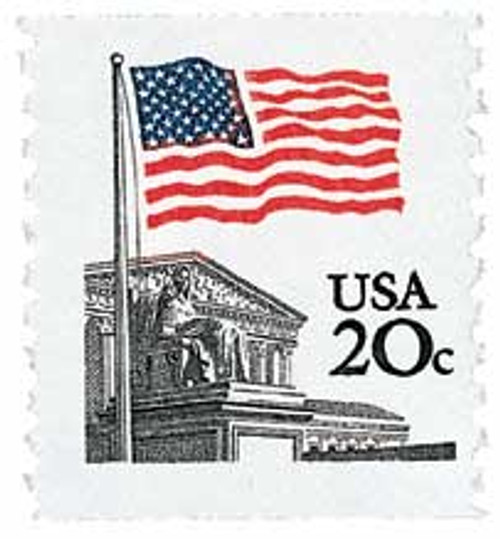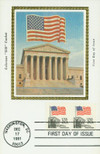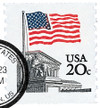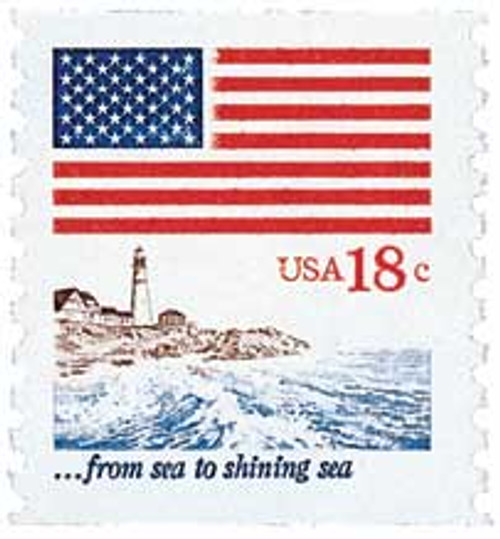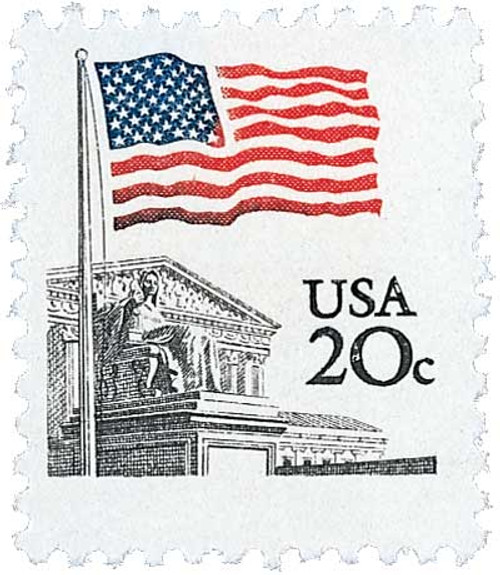
1981 20c Flag over Supreme Court, coil
# 1895 - 1981 20c Flag over Supreme Court, coil
$0.35 - $15.95
U.S. #1895
1981 20¢ Flag Over Supreme Court
Coil Stamp
1981 20¢ Flag Over Supreme Court
Coil Stamp
Issue Date: December 17, 1981
City: Washington, DC
City: Washington, DC
Printed By: Bureau of Engraving and Printing
Printing Method: Engraved
Perforations: 11
Color: Black, dark blue and red
Supreme Court
The powers and responsibilities of the Supreme Court are established in the U.S. Constitution. It is the highest court in the judicial branch of the federal government. The Supreme Court is the only court established by the Constitution. It has narrow original jurisdiction that is largely limited to cases involving ambassadors, public ministers, and states. Following the landmark 1803 Marbury v. Madison decision, the majority of its caseload involves appeals.
Congress determines the number of justices that sit on the court. The number of justices began at six and grew as the nation expanded geographically. The President of the United States appoints justices, who are not required to have any specific qualifications. Each nominee must be confirmed by Congress.
To allow justices to make their decisions without political influence or fear of reprisal, each justice shall hold their Offices during good Behavior, and may only be removed from the bench by impeachment.
The Supreme Court had a limited function for its first few decades, and the justices often rode the circuit to hear cases. President John Adams appointed John Marshall to the Supreme Court in 1801. In 1803, the Supreme Court heard the case of Marbury v. Madison, which found that a Congressional Act was unconstitutional. The Marshall Court declared any act that was "repugnant" to the Constitution to be illegal. The finding firmly established the concept of "judicial review," and made the Supreme Court an influential branch of the federal government.
Due to the power the court wields, Presidents are often eager to appoint justices that reflect their political ideology. To date, Jimmy Carter is the only President to serve a full term without the opportunity to appoint a member to the Supreme Court.
U.S. #1895
1981 20¢ Flag Over Supreme Court
Coil Stamp
1981 20¢ Flag Over Supreme Court
Coil Stamp
Issue Date: December 17, 1981
City: Washington, DC
City: Washington, DC
Printed By: Bureau of Engraving and Printing
Printing Method: Engraved
Perforations: 11
Color: Black, dark blue and red
Supreme Court
The powers and responsibilities of the Supreme Court are established in the U.S. Constitution. It is the highest court in the judicial branch of the federal government. The Supreme Court is the only court established by the Constitution. It has narrow original jurisdiction that is largely limited to cases involving ambassadors, public ministers, and states. Following the landmark 1803 Marbury v. Madison decision, the majority of its caseload involves appeals.
Congress determines the number of justices that sit on the court. The number of justices began at six and grew as the nation expanded geographically. The President of the United States appoints justices, who are not required to have any specific qualifications. Each nominee must be confirmed by Congress.
To allow justices to make their decisions without political influence or fear of reprisal, each justice shall hold their Offices during good Behavior, and may only be removed from the bench by impeachment.
The Supreme Court had a limited function for its first few decades, and the justices often rode the circuit to hear cases. President John Adams appointed John Marshall to the Supreme Court in 1801. In 1803, the Supreme Court heard the case of Marbury v. Madison, which found that a Congressional Act was unconstitutional. The Marshall Court declared any act that was "repugnant" to the Constitution to be illegal. The finding firmly established the concept of "judicial review," and made the Supreme Court an influential branch of the federal government.
Due to the power the court wields, Presidents are often eager to appoint justices that reflect their political ideology. To date, Jimmy Carter is the only President to serve a full term without the opportunity to appoint a member to the Supreme Court.

